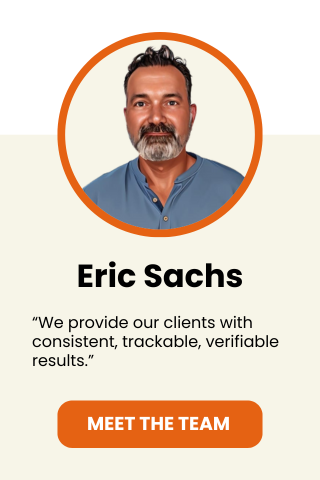
Local SEO is how local Southern California businesses can reach their prospective customers. Like traditional SEO, it involves a series of calculated steps to improve ranking in the search engines. A number one ranking is where you will get the biggest return on your investment, but number 1 rankings cannot be guaranteed and will certainly not happen overnight.
That’s why I want to show you a few things you can look at to see how well your local SEO efforts are performing. It can get discouraging if you don’t see ranking improvements, but that doesn’t mean the work being done is for nothing.
Overview
Track Ranking on Search Engines
Watch for changes in ranking for any of the keywords you are targeting. If you see a major change in rank, you know you’re getting a decent return on your investment. Take screenshots to show the changes in ranking so it is easier to demonstrate ROI to investors.
Ranking changes will likely increase slowly over time, but progress is being made. If you can increase your ranking quickly, this is wonderful, but will only make a difference in the long run if you can sustain the higher rank.
Track Calls from Leads
Using call tracking software, you can have your leads call a different phone number based on where they are coming to your website from. Your tracking system will connect with analytics and count it as a conversion. And attribute it back to the source.
Though this could be helpful, it’s important to display a consistent business phone number across the web because not doing so can affect your ranking negatively. Code your business phone number into your site using schema and monitor your local citations to make sure you’re talking numbers are not being picked up elsewhere.
If you notice calls are picking up, you know your efforts are working. If calls from a certain number are doing better than others, then you know that’s where you want to focus more of your efforts and budget.
Make Google Search Console Your Best Friend
- Pay attention to Click-Through Rate (CTR): You’ll be able to tell if you’re getting more clicks on your targeted keywords than you use to. This matters because it lets you know that your traffic is clicking through you your website. If you’re not seeing improvement, rewrite the title tags on your site.
- Keep an eye on search queries: Monitor the search queries that are bringing traffic to your website. Copy the data into a spreadsheet so you can watch for changes. Even if you don’t see a change in ranking yet, an uptick in traffic from certain phrases can show your SEO efforts are working.
Make Google Analytics Your Best Friend, Too
- Track link interactions: Find out which links people are clicking on, and if they’re using the click to call button on their mobile devices. Set up event tracking in Google Analytics for more insights.
- Find your most popular traffic sources: After people fill out a contact form, redirect them to a Thank you page. This way you can learn where your traffic is coming from, and you’ll know which methods are working so you can invest more of your resources on those.
Use the Google My Business Dashboard
You’ll be able to track impressions on your listings here, so you can see what kind of results you’re getting from the Map Pack. Since you can only go back 90 days, you’ll want to copy the data into a spreadsheet so you can watch for historic trends.
Use Year-Over-Year Comparisons if Necessary
If you’re in a seasonal business, comparing traffic on a month to month basis isn’t going to give you an accurate picture of what’s going on. Rely on the same month in the previous year to see how much you’ve grown.
The Formulas for Calculating ROI
Anticipated ROI – What You Expect to Earn
To calculate this, you must know:
- Average monthly visits – from Google Analytics
- E-Commerce conversion rate – also from Google Analytics if you’ve setup Goals and Conversion tracking
- Average order value (AOV) – Total amount of revenue divided by the total amount of orders
Let’s say your website gets an average of 60,000 visits and has a 1% e-commerce conversion rate. Your AOV is $100. Let’s say the proposed SEO project cost is $15,000. To break even, you must make at least $15,000 extra, and to generate a profit, you must produce a substantial amount of sales.
To determine the number of additional orders required for that breakeven point, you’d divide that $15,000 by the average order value of 100. You’d need 150 orders to break even.
Now, you need to determine the additional traffic required to generate those orders.
Take the number of orders required to break even and divide it by the ee-commerceconversion rate. 150/1% = 15,000 additional traffic.
To deliver a decent ROI, you should double that traffic volume and aim to drive 30,000 visitors with the campaign.
At this point, we can expect to get 200 orders through the SEO efforts, which would result in $30,000 in sales – creating a 100% ROI meaning for X, you’ll earn 2X.
Actual ROI – What You Earned
Your actual ROI is the total e-commerce revenue through SEO + the total goal value through SEO – the cost of running the SEO campaign/cost of running the SEO campaign.
Let’s say you ran that $15,000 campaign and ended up with $35,000 in sales. You got a bit more than 100% ROI.
You can also use another formula:
- K = volume of keywords searched
- S = % of searchers who became visitors
- D = % of visitors who became leads
- C = % of leads who become customers
- V = average customer value
- L = Local SEO revenue
(K) x (S) x (C) x (V) = L
ROI = (L – Cost) / Cost
Let’s say 7,500 people search for “Carlsbad plumber” every month. Only a small percentage of these searches will end up on your site. The percentage of course depends on where you rank. If you are higher on the 1st page, you’ll end up with a larger portion of those visits.
So, let’s take a look at what you could expect if you were at the bottom of page one compared to what you could expect if you were in the number 1 position for that keyword phrase.
In position 10, you can expect to earn about 3% of the search traffic. Of that hypothetical 7,500, that’s 225 visitors. If you rank lower than that, you can expect even less traffic.
But, if you were in position one, you could expect to earn about 40% of the traffic for that keyword which means you would get 3,000 visitors. It’s clear that it pays more to rank higher.
To keep the math simple, let’s assume that 5% of visitors in both ranking positions become leads since the vast majority of people who visit your website won’t take the time to contact you at all. Now you’ve got 12 leads (rounding up) at position 10, and150 leads at position 1.
We know that not every single lead will convert to a paying customer. Let’s assume that only 20% of those leads become paying customers. In position 10, you’d get 3 (rounding up) customers and in position one, you’d get 30.
If your average customer value is $200, you produced $600 in revenue in position 10 and $6,000 in position one.
If you’re spending a $750 a month in SEO services, and you’re left with $5,250 profit in the number one position and $150 loss in the number 10 position.
For every dollar you’re spending on SEO, you are earning $7 in return in the number one position. Though I’ve chosen completely arbitrary numbers, if you were in position 10 in this scenario, you would be losing money – 20 cents on every dollar – and therefore would need to increase your average customer value to make it worth it. If you spent less on your SEO, it would make it more difficult to increase your ranking quickly.
Knowing ROI is Important
Local SEO ROI can be found in many different ways. It’s important to look at the overall picture and focus on multiple metrics to see how well you’re doing. Choosing just one metric can skew your results.
2 Comments
Leave a Reply
Contact us today to get the conversation started!










Nice article Eric!
Thank you!